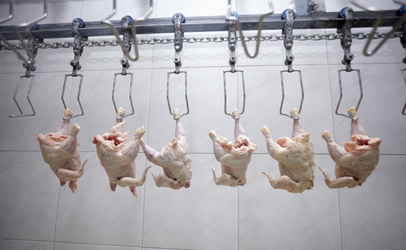 group of 68 members of Congress wrote to U.S. Department of Agriculture Secretary Tom Vilsack on Monday, asking him to suspend action on the proposed Modernization of Poultry Slaughter Inspection rule, which is based on the HACCP-Based Inspection Models Project (HIMP).
group of 68 members of Congress wrote to U.S. Department of Agriculture Secretary Tom Vilsack on Monday, asking him to suspend action on the proposed Modernization of Poultry Slaughter Inspection rule, which is based on the HACCP-Based Inspection Models Project (HIMP).“While we strongly support modernizing our food safety system and making it more efficient, modernization should not occur at the expense of public health, worker safety, or animal welfare,” wrote the group, led by U.S. Reps. Rosa DeLauro (D-CT), Jim Moran (D-VA), Louise Slaughter (D-N.Y.) and Bennie Thompson (D-MS).
The signatories asked that the agency suspend the rule in order to address various concerns, including those raised by the Government Accountability Office (GAO) report from August 2013.
The GAO report found that the Food Safety and Inspection Service (FSIS) had “not thoroughly evaluated the performance of each of the three pilot projects” because of limitations in the analysis of data from chicken plants and a lack of report on the turkey plants.
GAO listed responsibility and flexibility, more focus on food safety, and potential job creation and increased production as strengths of the program. But weaknesses included training, increased line speeds that have the potential to impact food and worker safety, and a reduced ability to see potential defects.
Ultimately, GAO called for FSIS to disclose to the public limitations in the information — including the cost-benefit analysis — and to continue evaluating its pilot project for young hogs “to determine whether the pilot project is meeting its purpose.”
“Shouldn’t USDA be addressing these data limitations so that we better understand the implications — including on food safety — before we move forward on the rule?” asked DeLauro of Vilsack during a House Appropriations Agriculture Subcommittee hearing on March 14.
In a written response to a draft of the GAO report, then-Undersecretary of Food Safety Elisabeth Hagen agreed with the recommendations and stated that when USDA issues the final rule, “FSIS will present the updated analyses, including the cost-benefit analysis, in a manner that will facilitate public understanding of the information used to support the rulemaking.”
At the hearing, Vilsack said he believed “that professionals at FSIS are confident in saying that there has been an increase of compliance with safety standards, equal to or fewer product safety issues in those plants than the general plants that we have and the other processes that we use, and equal to and fewer worker safety issues in those plants based on the data.”
He added that the program would provide “more inspections offline where we know pathogens attach, it would require more verification of compliance with standard operating procedures and with HACCP requirements … it would require new microbiological testing and record keeping that currently doesn’t exist, and it would make strong recommendations relative to worker safety.”
Another concern cited in the members’ letter sent Monday was the issue of worker safety. During the House hearing on Friday, Vilsack stated that, in terms of worker safety, there’s a difference between line speed in inspection and processing.
“The processing, which is where the worker safety issues arise,” are a function of equipment, facility layout, number of lines, flock conditions, and the number of employees involved, he said. “The rule would provide that, if there are compliance problems and process problems, that we would be able to shut the process down.”
Monday’s letter also questioned whether FSIS has studied the impact of the proposed rule on humane slaughter of poultry and whether it fully consulted stakeholders on the proposal.





